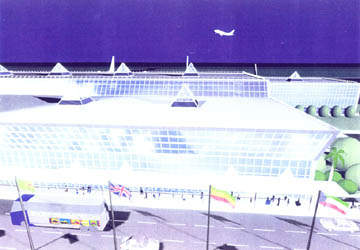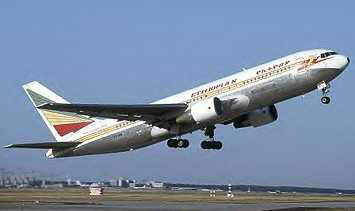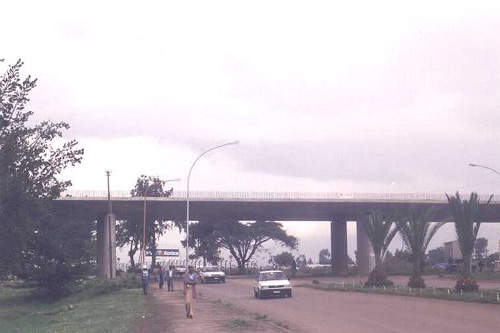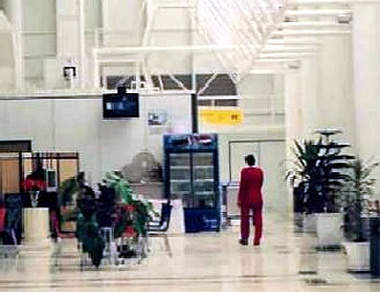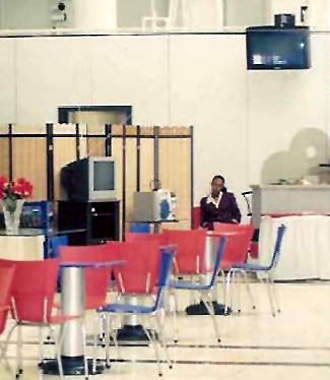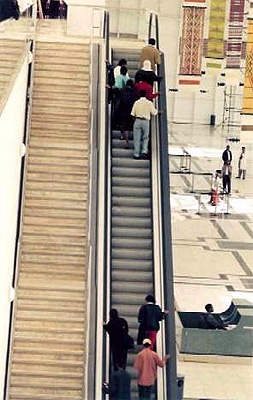Bole International Airport is located 8km south-east of Addis Ababa, Ethiopia and is the larger of the two international airports located in Addis Ababa, the second being the Lideta Airport which is located in the south-west of the capital.
In 1999, an expansion plan was announced at Bole International Airport (formerly known as Haile Selassie I International Airport, constructed in 1961 and renovated in 1971) at a cost of $130m (1.05bn Birr) in order to produce a new super hub for the African Continent
This involved the construction of a new 3,800m runway (07R/25L) running parallel to the existing runway (07L/25R, 3,700m), as well as five taxiways (including two with high-speed specification) linking the new runway to the existing runway.
It also involved the construction of a new airport terminal (an ultra-modern steel and glass structure), a car park, a shopping complex and restaurants.
In addition to this, the airport expansion involved the construction of a new control tower and the installation of state-of-the-art electrical and fire-fighting equipment, numerous accessories to the new terminal building and parallel runway, runway lighting, power generation, internal escalators, baggage carousels and conveyors, a public address system and other communication devices and installations.
The airport expansion was completed and opened in May 2003 and the new terminal took on the mantle of handling the majority of flights. The older terminal then underwent a radical refurbishment programme and was put back into operation in 2004 as a domestic terminal.
In December 2010, the Ethiopian Airports Enterprise announced another expansion project worth $27.9m at the airport. The project will include expansion of the aircraft parking capacity from 19 to 44 in order to accommodate heavier aircraft such as Boeing 747 and Boeing 777.
China Road and Bridge Corporation (CRBC) was awarded a $66m contract for the expansion project. CRBC will also upgrade the existing runway and expand the taxiway. The project is expected to be completed by July 2012.
In the first phase of the project, 15 parking areas will be constructed and the remaining will be completed in the next phase. The expansion will help in easing air traffic congestion due to increase in international travel.
Phase one
The runway was designed to handle any size of aircraft including Boeing 747s and Airbus A340s. The runway runs parallel to the existing runway and consists of five entrances and exits to the old runway, which serve as taxiways.
The cost of constructing the runway was estimated at $30m. Dar-al Handasah, a Lebanese company, was project consultant and Kajma Keanganam, a joint Korean and Japanese company, was the lead contractor.
Phase two
The second phase consisted of the construction of a new international terminal building, with a parking garage, a shopping complex and restaurants. It is a mainly steel structure. The cost of completing the second phase was estimated at $75m with the British firm, Fitchner, in charge of the project management and Al-Kharafi and Sons, a Kuwaiti company, as contractors.
The new terminal has a high and spacious design where the three levels are the height of a six-storey building. The shining steel and glass structure is an architectural and artistic masterpiece. Passenger convenience and service has led to space being increased by five times over the previous main terminal to 43,000m².
Five direct boarding gates stretch out on the new apron, allowing passengers quick and easy boarding and departure from aircraft.
The latest baggage handling facilities and services are provided, as well as expanded immigration and customs counters. The full range of modern facilities and services are available.
Modern communication and banking services are provided, and the food and shopping needs and wants of customer are fully catered for.
The inside of the terminal resembles a modern shopping mall, with plenty of space to meet all the requirements of the experienced international traveller. In anticipation of further growth the terminal was constructed with the capacity to handle, in the first phase of opening, 1,870 passengers an hour, and this can expand to over 3,000.
Phase three
The third phase was for the construction of the 38m control tower (double the height of the previous one) and installation of new electrical and fire-fighting equipment. It also included the provision of numerous accessories to the terminal building and parallel runway, runway lighting, power generation, internal escalators, baggage carousels and conveyors, public address system and other communication devices and installation.
The cost of completing the third phase of the project was estimated at $30m and the German company Siemens was the lead contractor. The priority of the Ethiopian Civil Aviation Authority was safety and special attention was given to the provision of state-of-art landing and navigation aids, improving communication and upgrading safety equipment on the ground.
Expansion rationale
The Ethiopian Civil Aviation Authority, which manages Bole Airport have developed a comprehensive National Airports Development Plan covering the period 1999–2017 and the expansion of the airport is a major part of the plan. The airport has had a 12-fold increase in capacity to handle six to seven million passengers annually from its previous capacity of 500,000 passengers.
The airport authorities have found that the expansion of the airport has turned Bole Airport into one of the major aviation capitals of Africa. Bole is now one of the main pilot training and aircraft maintenance centres in Africa. The provision of easy international connections at Bole has been a key element in the ambition of Addis Ababa to become one of the most global cities in East Africa. Good air connections are essential in attracting new business to the capital.
Addis is currently the emerging capital city in Africa, having been made the Headquarters of the African Union and also the base of the major UN agencies. The finance for the project was provided by the African Development Bank, the Arab Development Bank, OPEC, Nordic Development Fund and the Ethiopian government.
The new airport with its modern reliable infrastructure has certainly helped Addis bloom. The upgraded Addis Ababa Bole International Airport is now able to handle up to 17 aircraft simultaneously.
In 2005 Ethiopian Airlines announced that it intended to be Africa’s launch carrier for the Boeing 787 Dreamliner (since delayed) by placing a firm order for ten jets with an option for five more. The order was valued at $1.3bn.
Barcoded boarding
In March 2008 Bole International Airport became the first airport in Africa to implement 2D barcoded boarding passes for all international and domestic flights. This bold move circumvents the International Air Transport Association (IATA) requirement deadline by over two years (2010).
The system was installed by SITA (EAE has awarded them a five-year contract, which includes an upgrade to AirportConnect Open, making it easier to issue barcoded passes).
The installation includes the replacement of all check-in printers at the airport with 2D barcode-compatible machines and the introduction of 2D barcode readers at boarding gates. SITA’s remit also includes a new baggage management system (SITA Bag Manager).
The 2D barcode system allows passengers to print their own 2D barcoded boarding passes during e-check-in or alternatively to use SITA CUSS kiosks at the airport during self-service check-in. Bole is one of only five airports in Africa to have self-service CUSS check-in capability.

